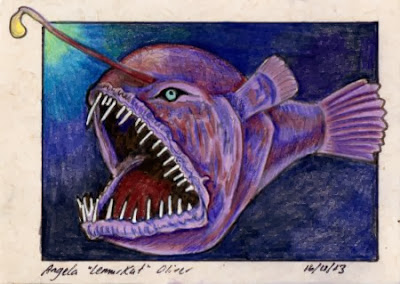About the Project
The ZooTrophy Animal-a-Day project began on October 15th, 2013 as illustrator Angela "LemurKat" Oliver began working her way, systematically but selectively, through the alphabet and presenting, via social media, an illustrated animal to the world. Daily.
All pieces are drawn as 2.5 x 3.5 inch collectible cards, using a combination of polychromos and prismacolor pencils, along with other art materials. Many are still available for purchase ($10) or trade, so drop her an email if anything captures your eye or if there is an animal you wish to request.
It is predicted this project will take her at least two years to complete - with approximately 36 animals being drawn for each letter. She has also used the images to create a collectible hardback encyclopedia series, playing cards and a desk calendar, as well as the ZooTrophy collectible trading card game.
All pieces are drawn as 2.5 x 3.5 inch collectible cards, using a combination of polychromos and prismacolor pencils, along with other art materials. Many are still available for purchase ($10) or trade, so drop her an email if anything captures your eye or if there is an animal you wish to request.
It is predicted this project will take her at least two years to complete - with approximately 36 animals being drawn for each letter. She has also used the images to create a collectible hardback encyclopedia series, playing cards and a desk calendar, as well as the ZooTrophy collectible trading card game.
Monday, November 18, 2013
Creature Feature #34: Anglerfish
This terrifying underwater denizen is a Humpback Anglerfish. She lives at depths of up to 2,000 m deep, where light never penetrates and her world is the murky black of darkest night. Therefore, she needs a light to show her the way - or to be precise, to show the males the way. And to lure food. She can measure up to 20cm long, and the males only measure 3cm. There are numerous species of anglerfish, almost all of which are hideous by human standards, which share similar traits - namely the light and predatory nature.
In some species of Anglerfish, the male locates his mate and then attachs himself to her permanently, his swimming organs atrophying away and in some cases actually connecting into her circulatory system, essentially becoming a new reproductory organ . Sometimes a female might collect a number of suitors in the form of these parasitic males. For the Humpback, the male of her species is free-swimming and remains so for all of his life, connecting with the female only to mate, which might be rather risky, given his diminutive size and the amount of voracious predators he shares the water with. Unlike some other species, he has well developed jaws and is capable of predating.
But how does this light work? Firstly, it is called an esca, and it is home to a species of symbiotic bacteria. These bacteria do not bioluminesce on their own, they require some sort of chemical input from the fish.
The other use for the esca is, of course, predation. The esca can be wriggled, to mimic a tasty morsel for a hungry fish, but then that hungry fish becomes the tasty morsel. Ah, but nature is cruel! Anglerfish possess an impressive array of teeth and enormous jaws. Their teeth are angled such that once the prey is swallowed, it cannot escape and their stomachs can distend to enormous size, allowing an anglerfish to eat prey up to twice the size of its body.
They say it's a dog-eat-dog world, but really, it's a fish-eat-fish world. Dogs rarely engage in cannibalism, but for many of the piscian origin, the only available food is other fish species. Of course, it's not cannibalism unless you are the same species.
Subscribe to:
Post Comments (Atom)


No comments:
Post a Comment